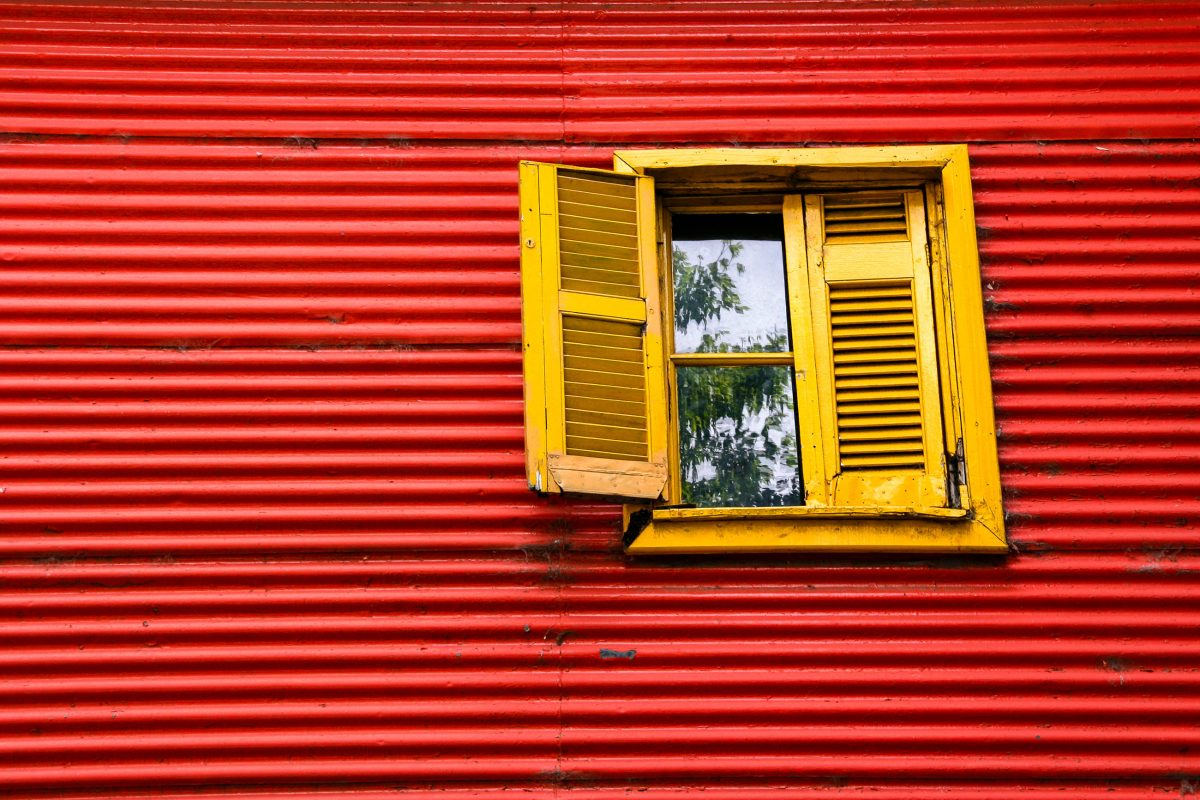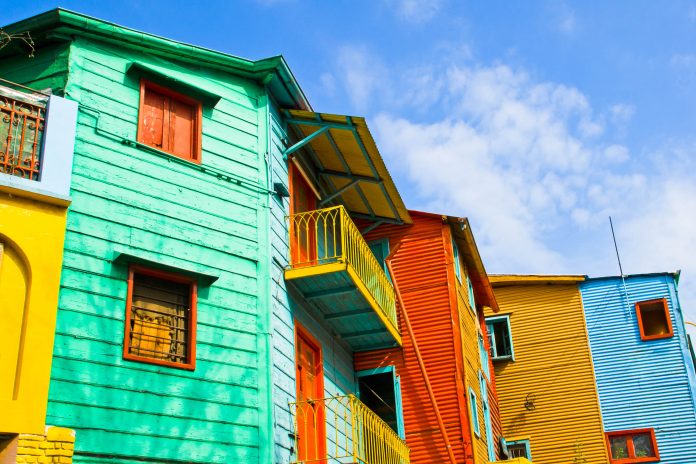La Boca ist wohl das bekannteste Stadtviertel der argentinischen Hauptstadt Buenos Aires. Seine Sehenswürdigkeiten sind vor allem die Häuser aus buntem Schiffsblech und das Fußballstadion „La Bonbonera“, Wirkstätte des großen Stars Diego Maradona.
La Boca ist wohl das bekannteste der 48 Stadtviertel der argentinischen Hauptstadt und zählt zu unseren Top 10 Sehenswürdigkeiten von Buenos Aires. Wie der Name bereits sagt (Boca = Mündung) liegt La Boca im Osten von Buenos Aires an der Flussmündung des Riachuelo in den Río de al Plata.
La Boca etablierte sich Ende des 19. Jahrhunderts als Zusammenkunft italienischer Einwanderer der Arbeiterklasse, die zum Großteil aus der italienischen Hafenstadt Genua stammten und in der Industrie beschäftigt waren. 1882 versuchte die Bevölkerung sogar, sich von Argentinien loszusagen und die genuesische Flagge zu hissen, was vom damaligen argentinischen Präsidenten Julio Argentino Rona jedoch rasch unterbunden wurde.
Sehenswürdigkeiten von La Boca

La Boca gilt als Geburtsstätte des Tangotanzes und ist vor allem durch seine außergewöhnlichen Wohnhäuser bekannt. Mangels Alternativen errichtete die Bevölkerung ihre Behausungen aus dem Blech von Schiffswracks, die teilweise die verschiedensten Farben bereits aufwiesen und teilweise noch mit farbenfrohem Schiffslack gestrichen wurden. So zeigen sich die Fassaden La Bocas als prächtiges Gemisch aus allen Farben des Regenbogens.
Die Tour durch La Boca beginnt am besten am Park Lezama und die Avenida Almirante Brown entlang. Vorbei an der Mural Escenográfico, einer Mauer mit Abbildungen von berühmten Persönlichkeiten aus verschiedenen Epochen geht es weiter zum Casa Amarilla („Gelbes Haus“), einer Nachbildung des imposanten Anwesens von Guillermo Brown, dem ersten Admiral der argentinischen Seemacht.
La Bombonera

Wenn Sie von dieser Straße rechts in die Straße Brandsen einbiegen, gelangen Sie direkt zum Estadio Alberto J. Amando, besser bekannt als La Bombonera („Die Pralinenschachtel“).
Im Stadion ist deutlich zu sehen, dass die Farbenpracht der übrigen Stadt auch das hiesige Fußballstadion der Boca Juniors nicht verschont hat. Das Team spielte Zeit seines Bestehens in der obersten Liga von Argentinien. Dank der kunstvollen Wandbilder von Pérez Celis blicken die Legenden der Boca Juniors bei jedem Match auf den Fußballrasen.
Das 60.000 Zuschauer fassende Stadion La Bombonera erstrahlt in leuchtendem Blau und Gelb, dem die heimische Fußballmannschaft auch seine Clubfarben verdankt. Nicht nur Fußballfans verspüren eine Gänsehaut wenn sie vor der „Heimat“ des großen Stars Diego Maradona stehen und vielleicht auch eine Tour durch die Umkleidekabinen und auf das Spielfeld selbst in Anspruch nehmen.
Warum heißt das Stadion der Boca Juniors Pralinenschachtel?
Das Stadion heißt nach einem ehemaligen Präsidenten der Boca Juniors seit 1986 eigentlich Estadio Alberto Jacinto Armando. Unter diesem Namen ist es jedoch nur eingefleischten Fußball-Fans bekannt. Sein Spitzname „La Bombonera“ („die Pralinenschachtel“), kam einst von den drei Tribünen-Ebenen und der D-Form des Stadions und hat sich bis heute offiziell durchgesetzt.
Noch nie der Hölle so nah….
Eingeweiht wurde La Bombonera nach zwei Jahren Bauzeit am 25. Mai 1940 mit einem Freundschaftsspiel gegen San Lorenzo, das die Boca Juniors mit 2:0 für sich entscheiden konnten.
Seit 1996 fasst das Stadion knapp 60.000 Zuschauer, deren Jubel an Match-Abenden in ganz La Boca zu hören ist. Aus Platzmangel fielen die Tribünen des Stadions ungewöhnlich steil aus, wodurch die Geräuschkulisse extrem verstärkt wird. Den Fans ist es somit ein Leichtes, als „La Doce“ („12. Mann“) die gegnerische Mannschaft einzuschüchtern. Dies ist vielleicht auch der Grund für die Aussage des brasilianischen Stürmers Romário, noch nie der Hölle so nahe gewesen zu sein wie im La Bombonera.
Die gewaltige Akustik wurde auch schon für zahlreiche Rock-Konzerte genutzt. Unter anderem begeisterten im La Bombonera bereits Lenny Kravitz, Elton John, die Backstreet Boys, die Bee Gees und James Blunt ihre Fans.
Museum der Boca Juniors
2001 wurde im La Bombonera das zweistöckige Museo de la Pasión Boquense eröffnet, welches die Erfolge der Boca Juniors seit ihrer Gründung im Jahr 1905 präsentiert. Dem Werdegang von Diego Maradona, bestem Spieler des Klubs, Trainer der argentinischen Nationalmannschaft und einem der weltbesten Fußballer, ist ein ganzer Saal darin gewidmet.
Kunst am Hafen von La Boca
Vom Fußballstadion Richtung Fluss weiter gelangt man auf die Hafenstraße, wo direkt von der „Flusskurve“ eine kleine, auf der Karte unscheinbare Straße abzweigt. Die nur 100 Meter lange Straße hat den passenden Namen El Caminito („Kleine Straße“) und fungiert als Freiluftmuseum. Einheimische Künstler präsentieren ihre Werke lautstark an den Straßenrändern, was sich so richtig in die bunte Atmosphäre La Bocas einfügt.
Im Clara Chevalier Museum wird man von der Künstlerin selbst durch die Reihen ihrer Werke geführt und erfährt Details aus ihrem Leben und ihrer Kindheit inkl. einem Nachbau ihres Kinderzimmers und eines alten Badezimmers.
Sicherheit in La Boca
Achtung: Die Sicherheit in La Boca ist oft fragwürdig – verlässt man die angestammten Touristenpfade, kann dies zu ernsthaften Problemen führen. Also unbedingt darauf achten, nicht die falsche Straße zu überqueren und im Zweifel den Touristenstrom nicht verlassen! Wer dennoch auch die Seitengasse von La Boca erkunden will, sollte ständig auf der Hut sein. Belohnt wird diese Mutprobe mit äußerst freundlichen Lokalbesitzern, die jeden Touristen, der sich in ihre Gegend verirrt, herzlich willkommen heißen und zu Spottpreisen ausgezeichnet bewirten.
Weiterführende Links:





